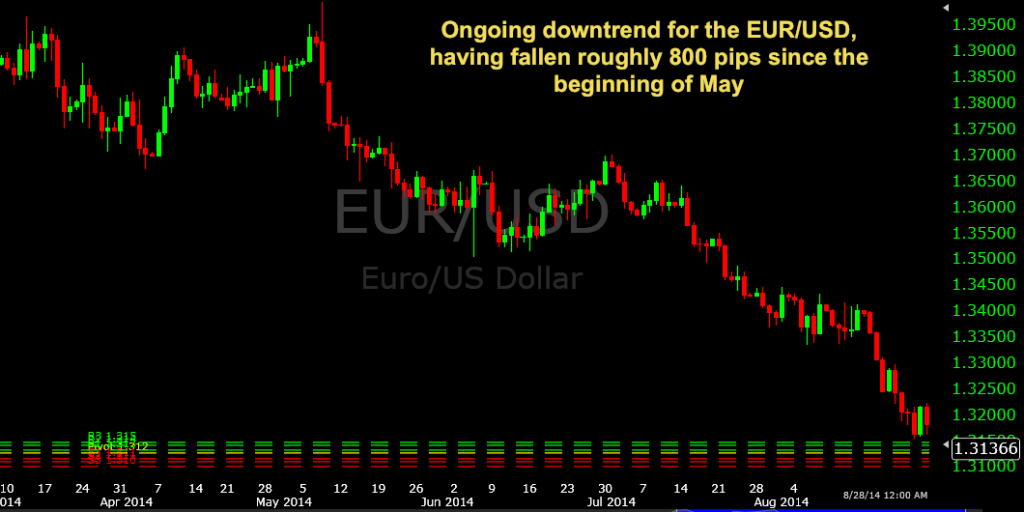How Examining Higher Time Compressions can Benefit Your Trading and The Post-Labor Day Outlook of the EUR/USD
September 1, 2014
As binary traders, especially for those of us who trade very short-term – e.g., 60-second options, 5-15 minute expiries – we often don’t really think about the broader scope of the market. When I do a trade analysis post, I’m almost always just providing my five-minute charts and a really up-close view of the market. It makes sense as, after all, when trading these short-term expiries you necessarily need to look at smaller time compressions for optimal results. Occasionally, I’ll throw in a daily chart when discussing recent multi-day, multi-week, and/or multi-month performance of the asset, but it’s really not a huge focal point.
But every now and then, it’s nice to take a look at the broad scope of the market and understand how things are going in terms of its broader view. Is it consolidating? Is it trending? Where might it go next and how might that influence what you do in your smaller-scale trades? I do swing trade forex, albeit in a limited fashion at the moment, as I have limited time, but it helps me stay abreast of the larger trends in play in the market. How are world economic factors contributing to what’s occurring on a day-to-day basis? Should you have a tendency to trade in one direction or the other based on this information?
Every day before I begin I always spend a decent 15-30 minutes to look at the higher time compressions, starting with the daily, and see what price levels could come into play and where might the market potentially go. Then I move down to the four-hour, then the one-hour, 30-minute, and 15-minute, until I’m at the 5-minute chart and more or less ready to focus on trading that time compression, looking for predicting which side of the fence price might be on after a 5-15 minute trade (i.e., the basic idea behind small timeframe binary options). It’s always a good ritual to get into and has helped me in my own trading.
In terms of overall outlook, the Euro has definitely been in a bit of a downfall this summer against other major currencies. The financial situation in Russia has been declining. U.S. data has been mostly positive which has led to the decline in this pair. Moreover, the European Central Bank is also considering additional monetary stimulus to fight against the economic stagnation in the Eurozone. Quantitative easing efforts are intrinsically depreciatory toward a currency, as more of it is pumped into the economy based on the simple decision-making of the central bank governing its dispersal. If data concerning the U.S. labor markets produces favorable results (in terms of beating expectations or roughly matching optimistic forecasts), this pair could continue to decline. Next week will be telling in its direction going forward. Non-farm payroll data comes out this Friday, September 5th.
The 1.3000 level is obviously a level to be monitored closely. If the U.S. labor situation looks sharp, it could target 1.3000 or even dip into the 1.2000’s, which hasn’t been seen in over a year. If the jobless claims and non-farm payroll data in the U.S. yield positive results, the Federal Reserve, head of U.S. monetary policy, could look to increase interest rates.
Interest rates are always a big factor when it comes to currency valuation. A higher interest rate increases demand for that currency from investors (because it leads to a higher return) and results in an appreciation of said currency. If that’s the case, you could look toward the idea of the USD making even more gains against the Euro.
Needless to say, a lot is still in the air. A bottom could come soon, but it really depends on continuous evaluation of macroeconomic variables respective to each of the world’s two biggest economies. As a trader, all of this is more relevant the higher the timeframe you use to base your trading off of. Although, of course, as a short-term binary trader, experiencing daily downtrends, which have been common recently, can certainly influence a predilection for put options. So even on the smallest of timescales, you may find – should find – that you’re statistically more likely to choose the direction of the overall prevailing trend that governs the more macroscopic time scales, like the four-hour compression and above.
